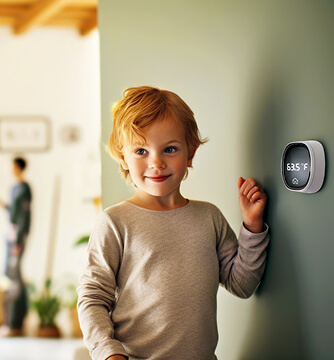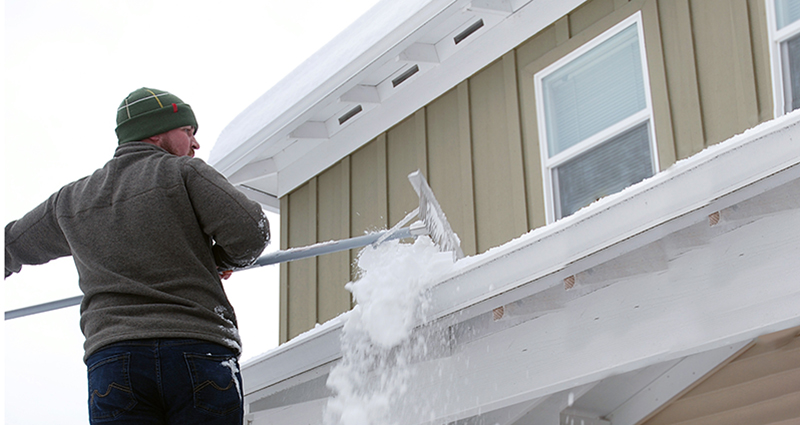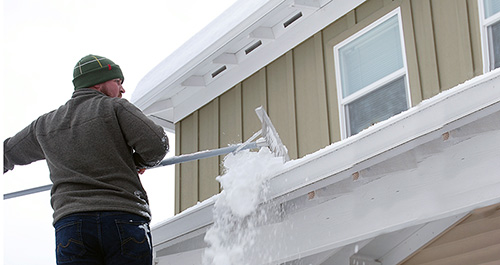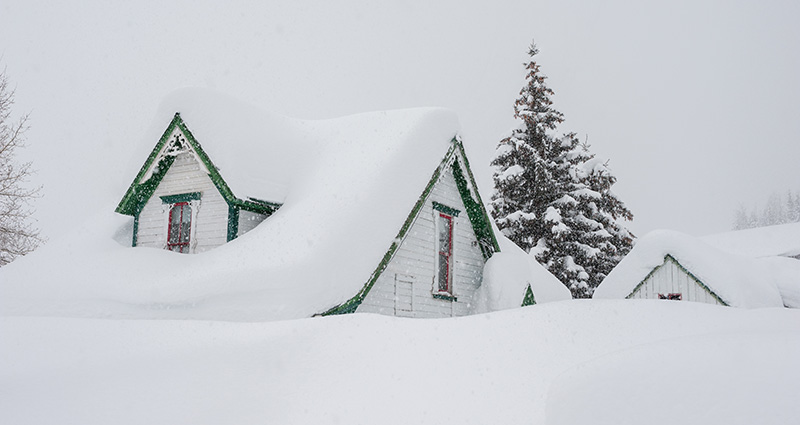Prepare your home in advance of winter storms
Long before any actual storms are on the forecast, you should stock up on what you need so you don’t miss out in a last-minute rush. Essential supplies include food, water and batteries, but also snow removal tools like a shovel and salt. If you own a snow blower, make sure it’s in good working condition and has plenty of fuel on hand before the first snowfall.
Eliminate outdoor electrical problems
You might not think of this winter safety tip, which is why it’s all the more important to check. Electrical problems can pop up any time of the year, but being prepared to handle one is especially crucial during the winter in case of a power outage or furnace failure. On top of that, damage to your electric system is a major fire hazard.
Prevent electrical problems by inspecting the outside of your home, specifically looking for damaged or frayed wires that are vulnerable to snow and ice. Check for any bird nests near electrical fixtures. If you find any, remove them as they are a huge fire hazard.
Inside your home, make sure all electronic decorations have tight-fitting connections: 3-prong outlets are optimal. These cords should be stored away from main walkways, and never beneath a carpet or rug, as this also creates a fire hazard.
Trim the trees
We all love trees and seeing them covered in white and fluffy snow, twinkling under the holiday lights, is a beautiful sight. However, if branches are too close to your home, or dead, they can pose a serious threat.
If a wintery mix strikes suddenly, it can cause ice to accumulate on your tree limbs before there's anything you can do about it. If the ice builds up too much, it can bring even sturdy branches crashing to the ground. So, it's important to trim your trees early in the season when the weather is more favorable.
Look out for branches that could hit your roof or come crashing through your windows and use caution when trimming branches near your power lines.
If an icy winter storm brings your power lines down under the weight of ice buildup or with a falling branch, DO NOT go near them. Call your electric company to report the problem immediately. The number will be on your electric bill, but if you can't access the number, you can also report it to your local police station.
Watch for water on your roof
Excess snowfall
Snow might not look like it, but it's heavy. A lof of snow on your roof means a lot of added weight and pressure. While it can fall off your roof on its own or melt, homes with flat or low-pitched roofs may need extra help if the snow accumulation is severe.
Signs that the weight of the snow is compromising your roof may include visible sagging in the snow buildup, ceiling leaks in your upper floor, cracks developing in interior drywall or masonry and creaking or popping sounds coming from the roof. In extreme scenarios, snow accumulation can lead to roof collapse.
Removing the snow yourself can be extremely dangerous, especially on multi-story homes or where there are already signs of roof damage. It’s a good idea to familiarize yourself with professional rooftop snow-clearing services in your area before severe winter weather strikes. The earlier you can get the snow cleared after a major snowfall, the more likely you are to prevent serious damage.
Icy gutters
Gutters should be cleaned out before the snow falls to help prevent water and ice buildup that could eventually find its way into your home. When colder weather arrives, clogged gutters can be spotted by looking for large icicles hanging from them or an accumulation of ice on the roof.
Icicles
While they look pretty, falling icicles can be extremely dangerous. It’s unsafe to use a ladder in icy conditions, so if there are large icicles on your home that are out of reach, it’s best to use caution and make sure no one stands beneath them until they melt on their own.
If icicles form in lower areas where they can be knocked down with a broomstick or shovel, you should perform this maintenance early and often, while the icicles are still small. Stand well to the side as you carefully knock them down.
Prepare your pipes for the cold
Winter safety tips aren’t just for outside of your home; they’re for inside and even under the foundation too. Prevent water issues by insulating water pipes exposed to freezing temperatures. Pipes that border an exterior wall have the greatest freezing potential, so they should be insulated with a towel or other piece of cloth.
In extremely cold weather, the water lines should be opened slightly to allow water to drip slowly into an indoor sink. This encourages water flow and makes freezing pipes less likely to occur. Neglecting your pipes can bring severe consequences, as the cost to repair damage ranges anywhere from $5,000 to $70,000, according to Cost Helper Home and Garden.
Keep your walkways clear
It’s important to keep walking paths near your house clear of snow and ice. Some local municipalities mandate that snow be shoveled from public walkways and sidewalks shortly after it falls, but even if this is not required, removing snow is essential to prevent slips and falls.
Once the snow is out of the way, cover icy patches with salt, sand or other type of commercial solution to deplete the ice and provide better traction. If you put a layer of salt down in advance of the storm, you can give yourself a head start on keeping things clear.
You should also be sure to wear appropriate shoes: either boots with rubber treads, or rubber overshoes or strap-on cleats to help give you traction with ordinary shoes. Walk slowly and carefully, taking small steps.
Shovel smart
Take care of yourself while you work on snow removal. Large snowfalls or any heavy and wet snowfall should be handled with a snow blower instead of a snow shovel. Shoveling snow is a high-intensity activity that puts stress on the heart, according to Harvard Medical School. Prolonged shoveling can also result in exhaustion and back injuries. It's important that all lifting be done from the knees, not the back.
If you must clear wet, heavy snow with a shovel, be sure to take frequent breaks in a warm area and make the job a little easier by spraying a coat of cooking spray on your shovel. It will help the snow clump together and prevent it from sticking to your shovel.
Pay attention where you walk
While you might do a great job keeping the walkways near your own house clear and safe, you can’t count on everyone making the same effort. Make sure you wear proper footwear when you leave the house, walk slowly and pay attention to where you put your feet. Ice especially can be tricky to spot and can cause potentially severe injuries from just a moment of carelessness.
Learn basic first aid
Winter storms can bring frigid temperatures and crushing precipitation, and the combination can be deadly for anyone caught outside. Make sure you know the signs of frostbite and hypothermia so you can spot these dangerous conditions quickly and provide proper treatment to the victim.
Ensure proper ventilation
The habitual cleaning of exhaust fans and filters in the bathrooms and kitchens should be done all year long, but it's especially important in winter because we spend more time indoors. This leads to more dust, more airborne particles from home cooking and more condensation from hot showers, all of which can cause indoor air quality issues in the absence of adequate ventilation and can even become a fire hazard.
This is also an excellent time to monitor other filters in your home, including cleaning out the dryer's filter and replacing the furnace filter. Furnace filters should be replaced once a month as doing so allows the HVAC system to operate properly and keep your home warm even when the weather outside is at its coldest.
Fight back against germs and viruses
Another side effect of families spending more time together indoors is that germs and viruses can be shared more easily. So, while handwashing is a good practice year-round, it's especially important during the winter cold and flu season.
It's also a good idea to keep hand sanitizer in accessible places around the home and to use it often if anyone's sick, or if there are very young or old people in the household.
Exercise caution when driving
When harsh weather pays a visit, the best option is to stay off the roads entirely. If you have no choice but to drive in the aftermath of a storm, practice safe winter driving. Stay on major thoroughfares that are most likely to be salted and plowed, and where you will be accessible to emergency workers in the event of an accident.
Use snow tires and chains if appropriate and accelerate and drive slowly. Be especially wary driving up hills and anywhere there’s likely to be ice on the roads.
Be prepared for a flood
Snow and ice are bad enough on their own, but additional concerns arise once temperatures warm up and everything starts to melt. It’s very common for drainage areas to be clogged with ice and snow, even after the spring melt begins.
Be aware of flooding from nearby waterways or in low spots on the road, but also keep an eye out for localized trouble spots around your house where water buildup can seep into your foundation and flood the basement. If you have a sump pump, check to ensure it’s working properly in advance.






































